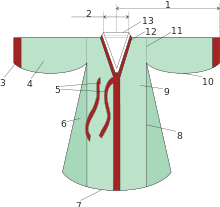Jeogori
| Jeogori | |
 A white jeogori with red goreum (ribbon) | |
| Korean name | |
|---|---|
| Hangul | 저고리 |
| Hanja | none |
| Revised Romanization | jeogori |
| McCune–Reischauer | chŏgori |
The jeogori (Korean: 저고리 Korean pronunciation: [tɕekoɾi];) is a basic upper garment of hanbok, Korean traditional garment, which has been worn by both men and women. It covers the arms and upper part of the wearer's body.[1][2][3]
Etymology
The jeogori has been worn since ancient times, and went by various names such as yu (유, 襦), boksam (복삼, 複杉), uihae (위해, 尉解) in the Three Kingdoms period (57 BC - 668 AD). Although it is unknown when the term, jeogori began to be used to refer the garment, it is assumed to have appeared in the late Goryeo period around King Chungnyeol's reign. The first historical document to mention the jeogori is Cheongjeonui (천전의, 遷奠儀) for Queen Wongyeong (원경왕후), which was a funeral ceremony for carrying the coffin out of the palace. The document written in 1420 during the second reign of Sejong the Great records jeokgori (赤古里) and danjeokgori (短赤古里). However, there is no certainty whether the record is a hanja (Chinese character) transliteration of a Korean word or Mongolian influence. Before the Goryeo period, such an upper garment was referred to as "uihae" (위해, 尉解) in Silla. As the uihae was a transliteration of the Silla language, dialects such as uti and uchi still remain to present.[1][2][3]
Composition

The basic form of a Jeogori consists of gil, git, dongjeong, goreum and sleeves somae. Gil (길) is the large section of the garment in both front and back side and git (깃) is a band of fabric that trims the collar. Dongjeong (동정) is a removable white collar placed over the end of the git and is generally squared off. The goreum (고름) are coat strings attached to the breast part to tie the jeogori.[4] Women's jeogori may have kkeutdong (끝동), a different colored cuff placed on the end of the sleeves. The form of jeogri has been changed as time goes by.[3]
There are several types of jeogori according to fabric, sewing technique, and shape.[3]
Gallery
-

Jeogori for women
-

-

-

See also
References
- ↑ 1.0 1.1 "저고리" (in Korean). Empas / EncyKorea. Retrieved 2008-09-29.
- ↑ 2.0 2.1 "저고리" (in Korean). Doosan Encyclopedia. Retrieved 2013-10-15.
- ↑ 3.0 3.1 3.2 3.3 "저고리" (in Korean). Empas / Britannica. Retrieved 2008-09-29.
- ↑ "Traditional clothing". KBS World. Archived from the original on 2008-03-17. Retrieved 2013-10-17.
- Lee Ho-jeong (2007-05-07). "Clothing with stories of fertility and faith". JoonAng Daily.
External links
| Wikimedia Commons has media related to Jeogori. |